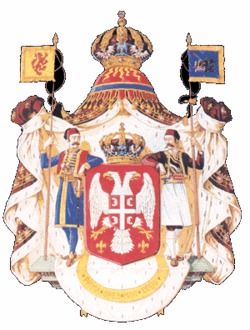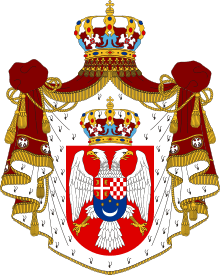Serbian heraldry
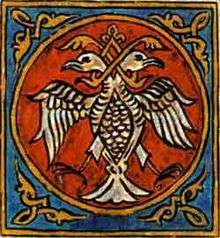 White double-headed eagle of Nemanjići | |
| Heraldic tradition | Central and Eastern European heraldry |
|---|---|
| Governing body | Serbian Heraldry Society |
The use of heraldry in Serbia or by Serbs is used by government bodies, subdivisions of the national government, organizations, corporations and by families. Serbian heraldry belongs culturally to the Byzantine tradition.
As in some other European heraldic traditions, the most prominent among the animals is the eagle.
The most prominent symbols is the Serbian eagle and the Serbian cross.
History

The history of Serb heraldry goes back to the medieval Serbian principalities (Rascia, Duklja, Travunia, Zahumlje, Pagania), Bosnia).
The current Coat of Arms of Serbia has origins in several other Serbian coats of arms.
Middle Ages
On 11 July 2006, A Golden seal of Strojimir of Serbia dated to 855-896 was bought by the Serbian state from an auction in Munich, Germany, by an unnamed Russian citizen. It was sold for EUR 20,000, outpaying the Bulgarian offer of EUR 15,000. It is of Byzantine handcraft (from Athens, Thessaloniki or Constantinople), weighs 15,64 g, has a Patriarchal cross and Greek inscriptions that say: "Strojimir" and "God, Help Serbia"[1]
Medieval Royal families include
- Nemanjić dynasty
- Mrnjavčević family
- Lazarević dynasty
- Balšić family
- Branković dynasty
- Crnojević family
Illyrist heraldry
The early phase of Illyrism begins in the late 16th century, with the genesis of an "Illyrian" heraldic tradition. The earliest such armorial was the so-called Ohmućević Armorial, dated to between 1584 and 1594, which survives in a 1595 copy. Several derived armorials of the 17th century survive; among these, the Fojnica Armorial has become notable in nationalist historiography as the "oldest Illyrian armorial", because it purports to be a compilation dating to 1340.
Austria-Hungarian heraldry
The serbs of Hungary, Austria & Austria-Hungary had their own noble, church & territorial heraldry. This heraldry can be seen most importantly in Vojvodina.
Revolutionary Serbia
The war flags of the first and second Serbian uprisings (1804–1815) are in several types.
The seal of the Serbian parliament had the Serbian cross and the Triballi boar.
Modern Serbian monarchy
The Principality of Serbia, Principality of Montenegro, Kingdom of Serbia, Kingdom of Montenegro & Kingdom of Yugoslavia had their own heraldry.
World War Two & Socialist Yugoslavia
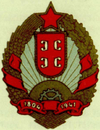
Socialist Serbia
Derived from the traditional shield of arms of Serbia with 4 fire steels (but without the cross). The Serbian cross was removed for ideological reasons of socialist atheism. It was placed above a rising sun with a cog wheel symbolizing the workers and surrounded with a golden wreath of maize and oak leaves, oak being a sacred Serbian tree. A red ribbon with dates 1804 and 1941 which refer to the dates of the first Serbian uprising against the Ottomans and the national uprising against the axis powers in the Second World War.
Contemporary heraldry
Republika Srpska & Federal republic of Yugoslavia that broke up into Republic of Serbia & Republic of Montenegro.

 Former COA Republika Srpska.
Former COA Republika Srpska.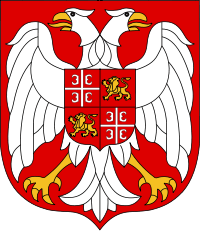
.svg.png) Republic of Serbia (2004-2010)
Republic of Serbia (2004-2010)
Coat of arms of Serbia
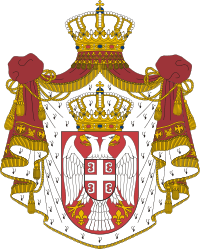
The modern Coat of Arms is derived from the House of Obrenović Coat of Arms, originating in the family of Orlovići, who had a white/black double headed eagle; however, the Obrenović, as did many other Serb noble families, adopted the eagle after Nemanjić dynasty, the most powerful Serbian dynasty.
The principal field stands for the Serbian State. It consists of a double-headed eagle on a red shield; its body and wings in silver, and tongues, beaks, legs and claws in gold, between two golden fleurs-de-lys. The inescutcheon stands for the Serbian Nation; in a red shield, a cross between four silver firesteels arranged in the quarters around it, all of them facing horizontally outwards.
A blazon in heraldic terms is: Gules, a bicephalic eagle Argent armed Or, two fleurs-de-lys Or. Overall an escutcheon Gules, a cross Argent between four firesteels Argent. All crowned with a royal crown. The design on the inescutcheon has been used by Serbian states and the Serbian church since the Middle Ages. The four letters around the central cross are commonly thought to be the letter, "C" (two forward, two backward). This comes from the well known Serbian phrase, "Само Cлога Србина Cпасава"(Cyrillic) or "Samo Sloga Srbina Spasava"(Latin) which translates to English as, "Only Unity Saves the Serbs". Many more scholarly schools of thought believe these letters to be the Greek letter B (betta) from the phrase: ΒΑΣΙΛΕΥΣ ΒΑΣΙΛΕΩΝ ΒΑΣΙΛΕΥΩΝ ΒΑΣΙΛΕΥΣΙΝ (The King of Kings ruling over Kings).
Although Serbia is now a republic, the new coat of arms also features the crown of the former Serbian monarchy. While unusual for republics, it is not unprecedented, as can be seen with the Republic of San Marino (it should be noted, though, that San Marino adopted a new crown to represent its sovereignty, and did not usurp a crown of a past sovereign).
Municipalities and Cities
|
|
|
Common themes
Serbian eagle
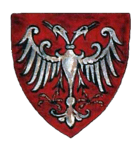
The double-headed eagle is a common symbol in Serb heraldry and vexillology, the heads represent the dual sovereignty of the emperor (secular and religious) and/or dominance of the Byzantine Emperors over both East and West. The Serbs have used the eagle as a symbol since the Byzantine Palaeologos dynasty. The Serbian cross has been used together with the Serbian eagle as late as the 14th century and is used in the contemporary design of the Coat of arms of Serbia.
Serbian cross

The Serbian cross is composed of a Cross and four Cyrillic "С" (Latin "S") alt. four firesteels.
The cross has been used by Serbian states and the Serbian Orthodox Church since the Middle Ages after Dušan the Mighty was crowned Emperor of the Serbs and Greeks (16 April 1345). Today it is the national, religious and ethnic symbol of Serbs and Serbia.
The modern interpretation is that the four symbols around the cross are Cyrillic letters С, an acronym of a slogan: "Only Unity Saves the Serbs" (Serbian: "Само Слога Србина Спасава" - "Samo Sloga Srbina Spasava") or "Saint Sava - Serbian Patron" (Serbian: "Cвeti Caвa - Cpпcka Cлaвa" - "Sveti Sava - Srpska Slava").
Wild boar
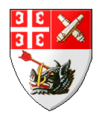
The Coat of Arms of Tribalia (Serbian: Грб Трибалије, Grb Tribalije) has a severed (cabossed or erased) Wild boar's head with an arrow through its head. The motif was used in the War flags of the First Serbian Uprising (1804–1813), alongside the common Coat of Arms with the Serbian cross.
In the collection Сабор у Констанци from 1415, the motif is used as the Coat of Arms of the Serbian Despotate and is recalled in one of Stefan Lazarević's personal Seals.
It is currently used in several Coats of Arms of municipalities.
St. George and the Dragon
St. George is a symbol of courage and valor, and the triumph of Good over Evil.
Head of a Turk
The severed head of a Turk, in reference to the wars with Turkey has been part of Serbian heraldry following the Ottoman Empire's conquest. It is depicted on several municipal coat of arms; Ada.
Other common elements
- The Tricolour flag of serbia is a common element of heraldry.
- Nature is a common element of heraldry, such as oak, olive, wheat, plum, grape...
- Weapons are a common element of heraldry, such as sword, cannon, gun, arrows...
See also
External links
References
| Wikimedia Commons has media related to Serbian coat of arms. |
- ↑ Pečat srpskog kneza Strojimira; Glas javnosti, 27 July 2006 (Serbian)

